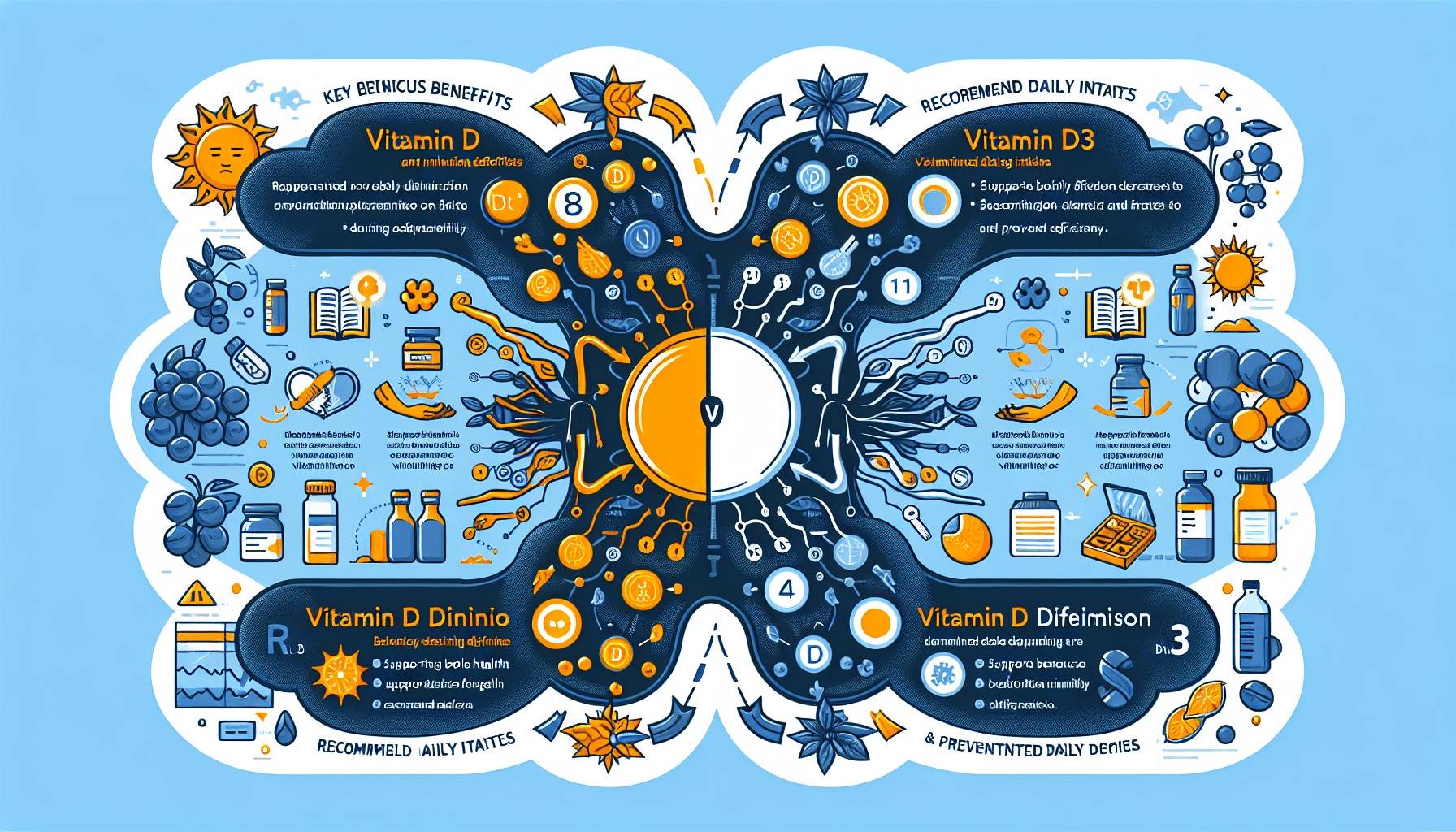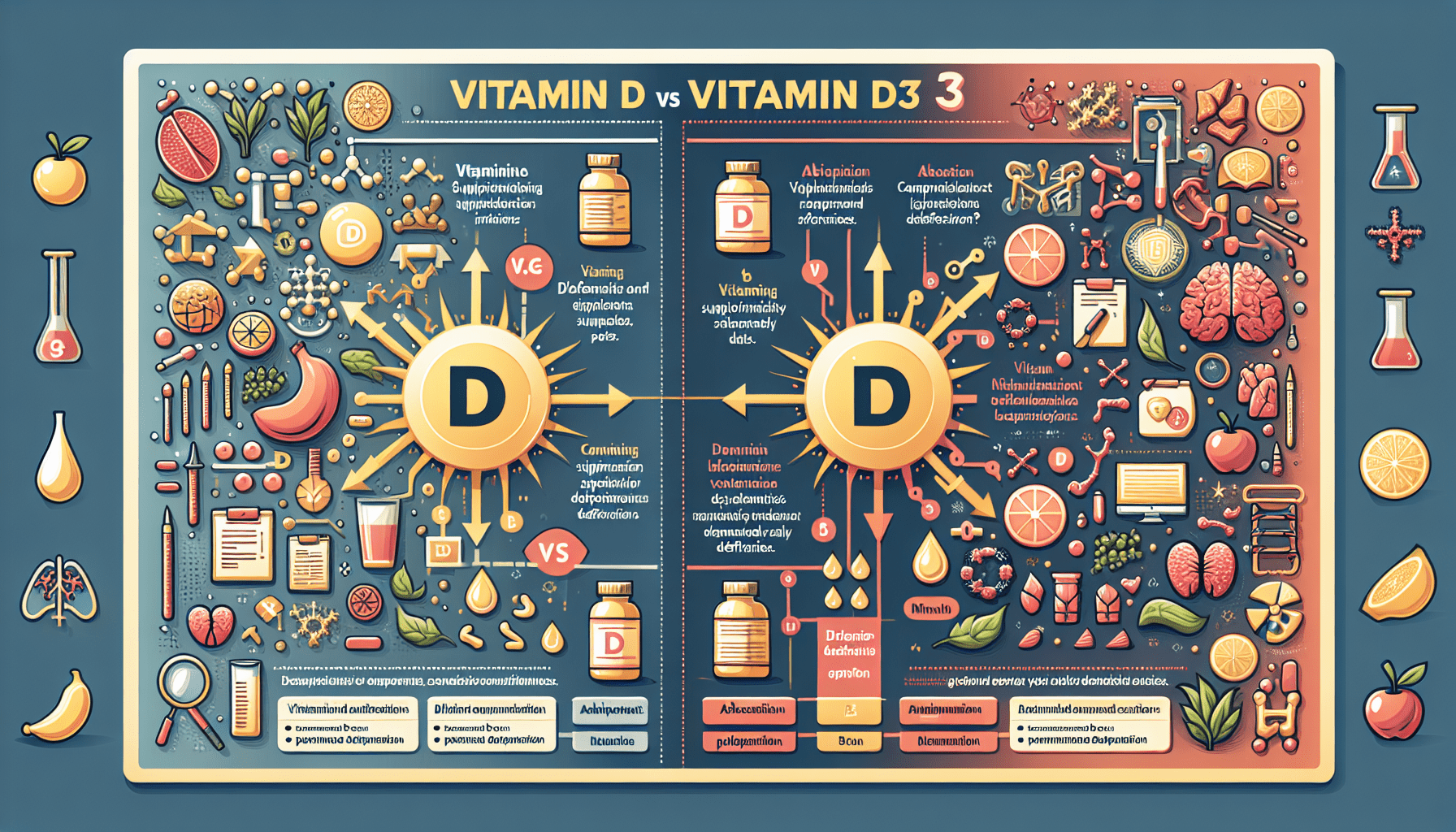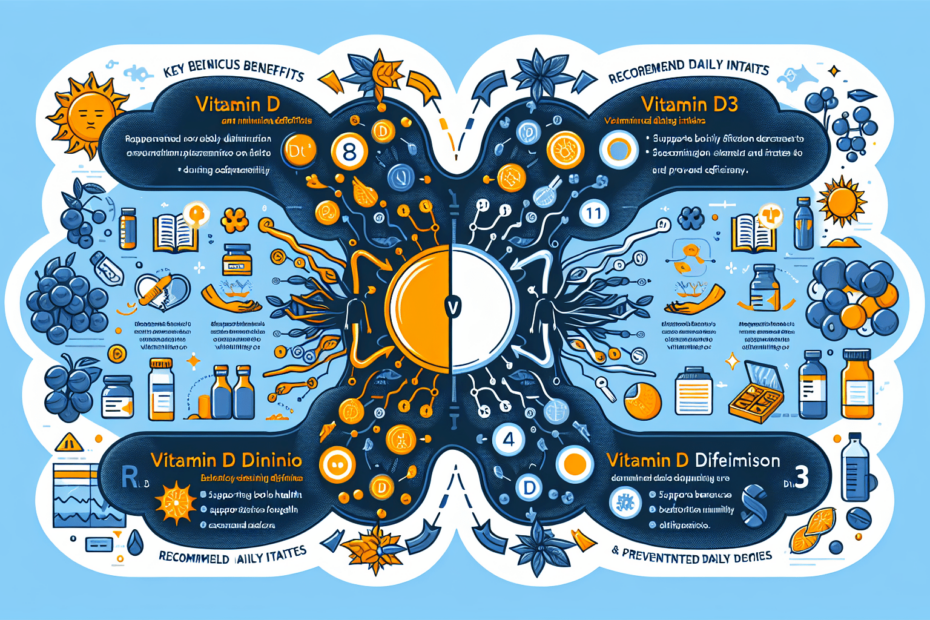







You may have heard about the importance of getting enough vitamin D for healthy bones and overall wellbeing, but have you ever wondered what the difference is between vitamin D and vitamin D3? While they may sound similar, these two forms of the vitamin are actually quite distinct. In this article, we will explore the dissimilarities between vitamin D and vitamin D3, shedding light on their sources, functions, and benefits. So, grab a cup of tea and get ready to unravel the mysteries behind these essential nutrients!
Chemical Structure
Vitamin D
Vitamin D, also known as calciferol, is a fat-soluble vitamin that exists in several different forms, including vitamin D2 and vitamin D3. Chemically, it belongs to the family of sterols, which are compounds that have a cholesterol-like structure. Vitamin D is characterized by its unique shape, consisting of a hydrocarbon ring structure with a side chain. This chemical structure allows it to interact with receptors in the body that are involved in various physiological processes.
Vitamin D3
Vitamin D3, also known as cholecalciferol, is a specific form of vitamin D that is naturally synthesized in the skin when it is exposed to sunlight. Chemically, vitamin D3 is derived from a precursor molecule called 7-dehydrocholesterol, which undergoes a series of biochemical reactions in the skin to convert it into its active form. Vitamin D3 is considered the most biologically active form of vitamin D and is the primary form that is used in supplements and fortified foods.
Source
Vitamin D
Vitamin D can be obtained from two primary sources: sunlight and dietary sources. When your skin is exposed to sunlight, a specific type of ultraviolet B (UVB) radiation triggers the conversion of 7-dehydrocholesterol into vitamin D3. This process happens in the skin and can vary depending on factors such as skin color, latitude, and season. Additionally, certain foods contain vitamin D, such as fatty fish (salmon, mackerel) and fortified dairy products.
Vitamin D3
As mentioned earlier, vitamin D3 is primarily synthesized in the skin when it is exposed to sunlight. However, it can also be obtained from dietary sources, similar to vitamin D. Vitamin D3-rich foods include fatty fish, liver, egg yolks, and fortified products like milk, yogurt, and cereals. Additionally, vitamin D3 can be obtained through supplements in the form of capsules, tablets, or liquid drops.

Synthesis
Vitamin D
Vitamin D synthesis starts with the conversion of 7-dehydrocholesterol in the skin by sunlight exposure. When UVB rays interact with 7-dehydrocholesterol, it undergoes a series of reactions that lead to the formation of previtamin D3. This previtamin D3 is then converted into vitamin D3 through a heat-dependent process. After synthesis, vitamin D3 is transported to the liver and kidneys, where it undergoes further conversions to its active form, which is essential for its biological functions.
Vitamin D3
Vitamin D3 synthesis primarily occurs in the skin, as described above. Once formed, it undergoes a similar metabolic pathway as vitamin D to reach its active form. In the liver, vitamin D3 is hydroxylated to produce 25-hydroxyvitamin D, also known as calcidiol. This intermediary form is further activated in the kidneys through hydroxylation, resulting in the formation of 1,25-dihydroxyvitamin D, also known as calcitriol, which is the biologically active form of vitamin D3.
Conversion
Vitamin D
Once produced in the skin or ingested from dietary sources, vitamin D undergoes conversion in the liver and kidneys to become its active form. In the liver, vitamin D is hydroxylated to produce 25-hydroxyvitamin D. This form serves as a storage form and is the most commonly measured indicator of vitamin D status in the body. When needed, 25-hydroxyvitamin D undergoes further hydroxylation in the kidneys to form 1,25-dihydroxyvitamin D, which is the active hormone involved in regulating calcium metabolism and maintaining bone health.
Vitamin D3
Similar to vitamin D, vitamin D3 also undergoes conversion in the liver and kidneys to become its active form. In the liver, vitamin D3 is hydroxylated to produce 25-hydroxyvitamin D3, which serves as the storage form. This is followed by a second hydroxylation step in the kidneys, resulting in the production of 1,25-dihydroxyvitamin D3, the biologically active form of vitamin D3. This conversion process ensures the availability of active vitamin D3 in the body for its various functions.

Function
Vitamin D
Vitamin D plays a crucial role in various physiological processes in the body. One of its primary functions is the regulation of calcium and phosphorus absorption in the intestines, which is essential for maintaining bone health. Additionally, vitamin D is involved in promoting calcium deposition in bones, regulating immune function, cell growth, and differentiation, reducing inflammation, and potentially influencing cardiovascular health and brain development.
Vitamin D3
Being the active form of vitamin D, vitamin D3 performs the same functions as vitamin D. It helps in the absorption of calcium and phosphorus from the intestines, promotes bone mineralization, regulates the immune system, supports cell growth and differentiation, and plays a role in reducing inflammation. Vitamin D3 is vital for overall bone health, as it helps in preventing conditions like osteoporosis and rickets.
Bioavailability
Vitamin D
The bioavailability of vitamin D depends on various factors, including the source of intake and individual characteristics. When vitamin D is obtained through sunlight exposure, its production is influenced by factors such as skin pigmentation, latitude, time of day, season, and sunscreen use. In terms of dietary intake, vitamin D absorption is enhanced when consumed with fat, as it is a fat-soluble vitamin. However, conditions that affect fat absorption or digestion can potentially impact the bioavailability of vitamin D.
Vitamin D3
The bioavailability of vitamin D3 is similar to vitamin D since vitamin D3 is the active form that the body utilizes. It is well-absorbed when obtained through sunlight exposure, and its production is influenced by similar factors as vitamin D. Regarding dietary intake, vitamin D3 from foods or supplements is readily absorbed in the small intestine due to its fat-soluble nature and does not require extensive conversion to be utilized by the body.
Supplement Availability
Vitamin D
vitamin D supplements are widely available and can be found in various forms, including capsules, tablets, liquid drops, and even fortified foods. These supplements provide a convenient way to ensure adequate intake of vitamin D, especially for individuals who have limited sun exposure or have difficulty obtaining sufficient amounts of vitamin D through diet alone. Different supplement strengths are available, allowing for flexibility in dosage based on individual needs and healthcare provider recommendations.
Vitamin D3
Similar to vitamin D, vitamin D3 supplements are readily available in a variety of forms, including capsules, tablets, and liquid drops. Vitamin D3 supplements provide a convenient and reliable option for maintaining optimal vitamin D levels when natural exposure to sunlight is limited. They are commonly used to address deficiencies, support bone health, and promote overall wellness. It is important to note that the dosage of vitamin D3 supplements should be determined based on individual requirements and in consultation with a healthcare professional.
Benefits
Vitamin D
Adequate vitamin D levels offer numerous health benefits. One notable benefit is its role in promoting optimal bone health. Vitamin D helps in the absorption of calcium, which is crucial for strong and healthy bones. It also plays a significant role in reducing the risk of osteoporosis, a condition characterized by weakened bones. Besides bone health, vitamin D has been associated with improved immune function, reduced risk of certain cancers, cardiovascular health, and mental well-being.
Vitamin D3
As the active form of vitamin D, vitamin D3 offers the same benefits as vitamin D. Its role in promoting calcium absorption and bone mineralization contributes to optimal bone health. Adequate vitamin D3 levels have been associated with a reduced risk of osteoporosis and fractures. Vitamin D3 may also play a role in immune function, reducing the risk of certain diseases, and supporting overall wellness. Ongoing research is exploring potential benefits of vitamin D3 in areas such as cardiovascular health, mental health, and cancer prevention.
Recommended Daily Intake
Vitamin D
The recommended daily intake of vitamin D varies depending on age, sex, and individual circumstances. In general, the recommended dietary allowance (RDA) for vitamin D is 600-800 International Units (IU) per day for most adults. However, certain groups, such as infants, children, pregnant and breastfeeding women, and older adults, may have different requirements. It is important to consult with a healthcare professional to determine the appropriate dosage of vitamin D based on individual needs and considerations.
Vitamin D3
Since vitamin D3 is the active form of vitamin D, the recommended daily intake is similar to that of vitamin D. The RDA for vitamin D3 is also 600-800 IU per day for most adults. However, specific requirements may vary depending on age, sex, and individual circumstances. Infants, children, pregnant and breastfeeding women, and older adults may have different needs and may require different dosage recommendations. It is always advisable to consult with a healthcare professional to determine the appropriate intake of vitamin D3 for optimal health.
Deficiency
Vitamin D
Vitamin D deficiency is a common concern, especially in regions with limited sunlight exposure and for individuals with certain lifestyle factors. Inadequate vitamin D levels can lead to various health problems, including the risk of developing rickets in children and osteoporosis in adults. Symptoms of vitamin D deficiency may include bone pain, muscle weakness, fatigue, and an increased susceptibility to infections. Regular monitoring of vitamin D levels and appropriate supplementation is essential to prevent deficiency and maintain optimal health.
Vitamin D3
Vitamin D3 deficiency poses similar risks as vitamin D deficiency since vitamin D3 is the active form utilized by the body. Inadequate levels of vitamin D3 can lead to impaired calcium absorption, weakened bones, and an increased risk of fractures. Symptoms of vitamin D3 deficiency may include muscle weakness, bone pain, frequent infections, and low mood. If deficiency is suspected, a healthcare professional can assess vitamin D3 levels through blood tests and recommend suitable supplementation to address the deficiency and prevent associated health issues.
In conclusion, vitamin D and vitamin D3 are essential nutrients that play crucial roles in various physiological processes. While vitamin D refers to a group of compounds, vitamin D3 is the most biologically active form. Both vitamin D and vitamin D3 can be obtained through sunlight exposure and dietary sources, or through supplements. They have similar functions, including supporting bone health, promoting calcium absorption, regulating the immune system, and potentially influencing other aspects of health. It is important to ensure adequate intake and monitor vitamin D or D3 levels to prevent deficiencies and maintain overall wellness. Consultation with a healthcare professional is recommended to determine individual requirements and optimize vitamin D status.







